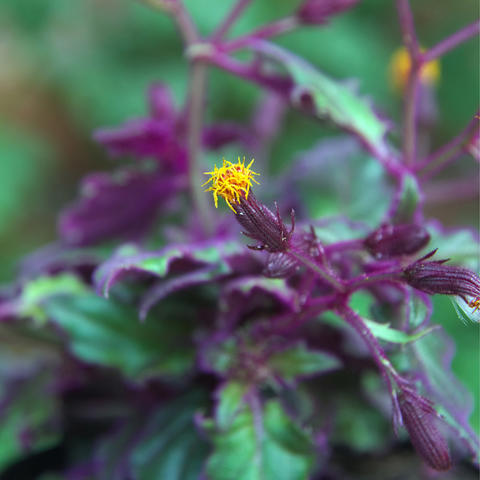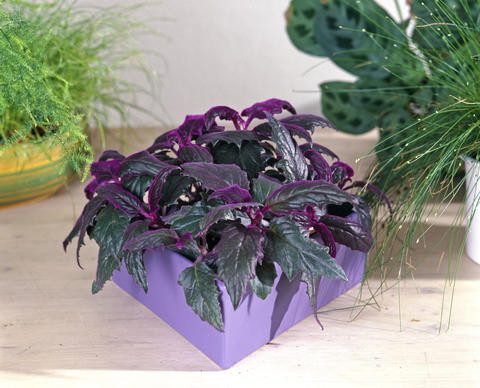Gynura, Purple Passion
The plant is true to its English name “Purple Passion” (Gynura aurantiaca): With its purple hairy leaves it looks truly exotic among houseplants.
Factsheet
- Growth type
-
- half shrub
- Growth height (from)
- from 20 cm to 30 cm
- Growth characteristics
-
- upright
- overhanging
- Tendrils
- Flower color
-
- yellow
- orange
- Flowering time (month)
-
- January to February
- November to December
- Flower shape
-
- panicles
- Flower characteristics
-
- non-pleasant odor
- Leaf color
-
- green
- multicolored
- page format
-
- toothed
- oblong
- pointed
- Light
-
- sunny to scattered light
- Soil type
-
- sandy to loamy
- Soil Moisture
-
- fresh to humid
- ph value
-
- weakly acidic
- Lime compatibility
-
- sensitive to lime
- Nutrient requirements
-
- nutrient-rich
- Humus
-
- rich in humus
- Decorative or utility value
-
- Flower Decoration
- Leaf ornaments
- Toxicity
-
- toxic
- Use
-
- Interior greening
- Planters
- Winter garden
- Garden style
-
- Pot garden
Gynura aurantiaca belongs to the sunflower family (Asteraceae) and is originally from the Indonesian islands of Java and Sulawesi. We cultivate the purple passion as a colorful houseplant. When planted at suitable location, it is quite easy to care for and attracts everyone's attention: The fine, purple-colored hairs give the otherwise dark green plant a velvety and shimmering appearance. It is not for nothing that it is also called "Purple Velvet Plant" or "Purple Passion" in English. Besides that, the orange-yellow flowers create a vibrant play of colors along with the violet shimmer. Unfortunately, the flowers are not an olfactory highlight.
The Purple Passion is a subshrub that can reach a height of over 6.56 feet in the tropical climate. As an indoor plant, however, it remains significantly smaller, where a height of between 7.87 to 11.81 inches. Not only can the Gynura grow upright, but it can also have long, climbing shoots. Therefore, it is also well suited for planting hanging planters. A note of caution: All parts of the Gynura plant are poisonous.
The alternately arranged leaves of the Gynura are oblong with a pointed tip and are roughly serrated at the edges. They appear dark green and have a velvety surface, which they owe to the dense, violet to purple colored hair. The stems and flower stalks are also hairy.
The flower heads of the Gynura aurantiaca are arranged in panicles and each hold numerous orange-yellow tubular flowers. They usually appear in the winter months and have a strong fragrance. If you don't like the scent, the flowers can be clipped off.

The Purple Passion grows well in a very bright and humid location all year round. The place can be sunny, but you have to protect it from direct midday sun. If it is too dark, the purple hair of the Gynura is also less intense - the leaves turn green. In spring and summer, a room temperature of over 68 degrees Fahrenheit is ideal. In the winter months, it can tolerate slightly cooler temperatures of 64.4 degree Fahrenheit.
Plant the Gynura aurantiaca in high-quality, permeable potting soil. The pH value should be around six, i.e. in the weakly acidic range.
Always keep the substrate of the Gynura slightly moist. So water the plant moderately and make sure that the substrate never dries out completely. Although it prefers high humidity, the leaves of the purple passion should never be sprayed directly with water. It is better to place the flower pot on a bed of gravel in a bowl filled with water.
Fertilize the purple passion weekly in spring and summer. In the winter months, fertilize less; every two to three weeks, is sufficient. Simply add some liquid flower fertilizer to the water.
Gynura aurantiaca grows quite quickly and, with the right care, can also grow tall in few years. Repotting is then possible all year round. However, the older plants no longer look so attractive: Only the young Purple Passion plants have an intense purple-violet leaf color. Therefore, the exotic houseplant must be typically replaced after every two years. Repotting is not necessary in this case.

If you want to keep the Purple Passion plant compact, you can clip off the shoot tips regularly. So the plant grows bushier.
The Gynura plant can be easily propagated by terminal cuttings - so you can look after its beautiful offspring every year. To do this, cut off about 3.93 inches long leaf shoots with a sharp knife and remove the lower leaves. Then the cuttings are placed in a seed tray filled with potting soil, which can be covered with a transparent plastic cover. Put the bowl in a bright, warm place. Important for planting success: The Gynura cuttings take root at a soil temperature of at least 68 degrees Fahrenheit.
Gynura aurantiaca is attacked by aphids quite frequently. Frequently check the Purple Passion for pests, in order to avoid greater damage or infestation of other indoor plants. Make sure that the Gynura plant is in a not placed in a very warm and airy place.

